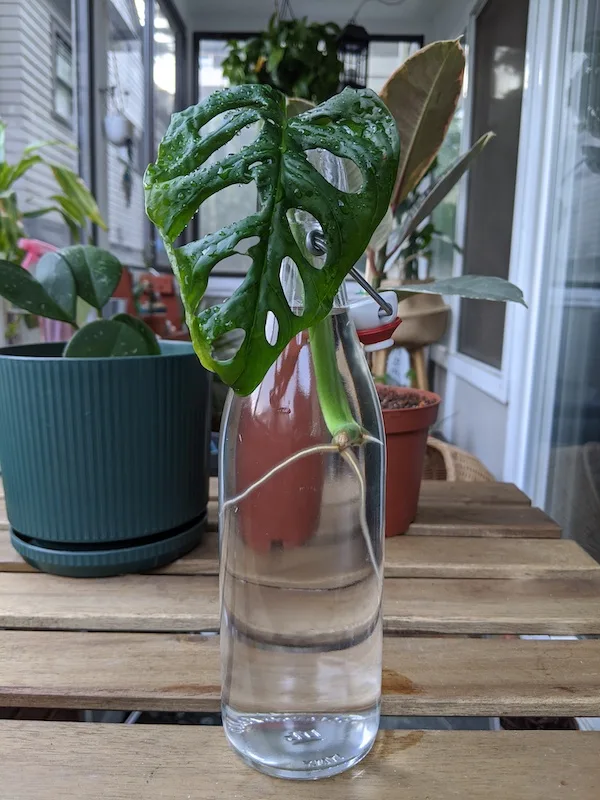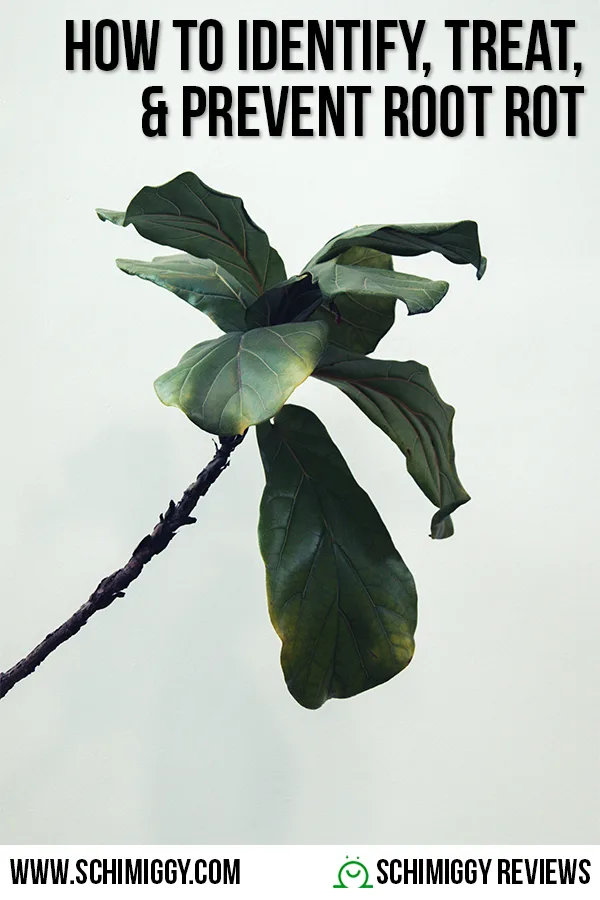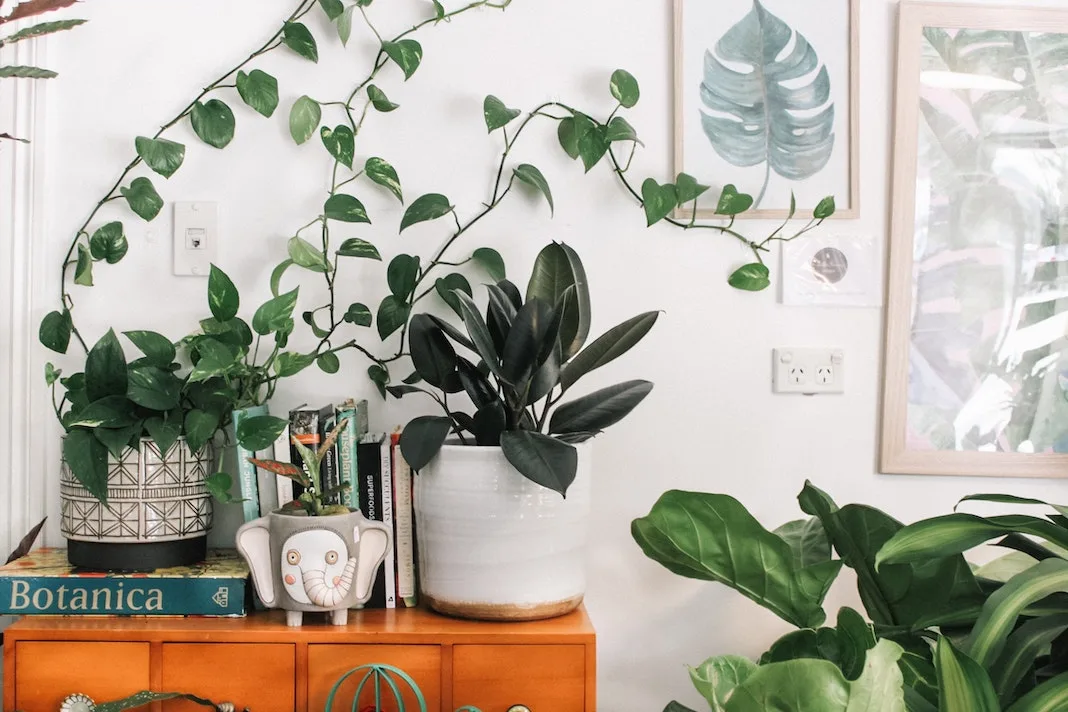In this article, we will learn to identify, prevent, and treat root rot before it’s too late to save your plant.
What is Root Rot?
Root rot is when the roots on your plant start to rot. Instead of being a tan color, the roots start to turn a dark reddish-brown. It’s a common plant disease that can easily be prevented and treated.
Other signs of root rot may include:
- Leaves dropping
- Leaves turning brown or yellow
- Your plant falling to the side because it’s unable to stand upright
- Mushy stem typically found near the base of the plant
- Slow growth
- Distorted leaf growth (some small and some big leaves or wrinkly leaves)
What Causes Root Rot?
Root rot is typically caused by overwatering or not enough drainage. Water saturates the soil and cannot fully be absorbed by the plant, and the roots start to “drown” and become “suffocated.” Therefore it causes root rot and could eventually kill your plants.
This issue is very common with indoor plants and for those new to plant care. It can also happen to outdoor plants if the drainage system is not adequate.
How to Prevent Root Rot
Here are the steps you need to take to prevent root rot.
- Do not overwater your plants. This is the best way to prevent root rot! Soil can become oversaturated with water and cause root rot.
- Use pots with drainage holes and ensure that your plant is not sitting in a tray full of water. We like these white pots with drainage holes and trays.
- Water your plants less in the Fall and Winter and more in the Spring and Summer. A great way to gauge if your plant needs water is by using your pointer finger to see how dry the top of the soil is. If the soil is dry at least 1-2 inches, then it would be a good time to water your plant. Different plants also have different water needs.
- Use .5″ to 1″ of stones or pebbles at the bottom of your pots to help with drainage. Add stones to the top of your soil to prevent gnats as well. You’ll also use less soil when you use stones in your pots.
- Loosen compact soil. Compact soil happens due to normal watering and can suffocate your plants. Sediment from the top fills the spaces and cracks in your soil over time. Breaking up compact soil is great for giving your plants room to breathe and preventing root rot. I use my fingers to loosen compact soil. And when I have more time, I remove the soil from the pot and plant, fluff up the soil then repot my plant.
- Aerate your soil. If you’re not one for going the route of loosening your soil, you can aerate your soil instead. Use a wooden chopstick and poke holes throughout the soil. Some root breakage may occur and that is OK. The holes will allow air to flow through your soil better and help prevent root rot.
- Do not use plant food or fertilizer in the Fall or Winter seasons. All these added nutrients will make your plants work harder and stress them out during the seasons where they are not growing as quickly or robustly. Give your plants a break during Fall and Winter with sparse watering and grow lights. We recommend using smart release plant food and fertilizer during the Springtime and it lasts through Summer.
Related: How to Keep Your Indoor Plants Alive in the Winter
How to Save Your Plant from Root Rot
If you suspect your plant has root rot, here are the steps to take to save your plant!
Step 1: Check for Root Rot
Remove the plant from the soil with your hands and check to see if the roots are healthy. Use your fingers to gently dig around the plant until the soil breaks up and you can see the roots. I tend to set soil aside in another bowl or bucket while I check for root rot.
If the roots are a tan color and firm to the touch, this means they are healthy.
If the roots are a reddish brown color, that means your plant has succumbed to root rot! Follow the next steps to save your plants.
Step 2: Remove the Plant from Soil
Once you’ve checked for root rot, it’s time to remove the plant from the soil.
Take a butter knife and break the soil away from the pot by agitating the space between the pot and soil. Turn the pot upside down in trash can or sink and remove the base of the plant from the pot. Set the pot aside.
Use your fingers to pinch the soil so that it starts to crumble and fall off the roots. This will take some time, so make sure you have a chunk of your day set aside to save your plant.
Step 3: Dump the Old Soil
Throw the old soil away. I just dump it in our landscaping area to get reabsorbed by the surrounding plants.
Step 4: Clean and Cut Off Root Rot
Rinse the roots under running water to remove any of the old soil. Use a pruner or garden shears to cut off the rotted roots leaving new healthy roots intact.
Step 5: Water Propagate your Plant for 1-2 Weeks
You can re-pot your plant immediately, but we prefer to water propagate and re-grow healthy roots.
To propagate your plant, place your roots in a glass container with fresh water and place your plant in indirect sunlight. Wait 1-2 weeks for your roots to grow. Make sure you keep an eye on the plant in case anything goes awry. You should be able to see existing and new root growth.
Relate: Guide on How to Water Propagate Plants

Week 3 of Monstera Adansonii Propagation
Step 6: Re-Pot Your Plant with Fresh Soil
After 1-2 weeks, re-pot your plant back into a pot with fresh soil. Make sure you use soil that does not easily compact so that your plant can thrive.
We like using this soilless mix recipe post propagation:
- 4 to 6 parts sphagnum peat moss or coir (coconut shards)
- 1 part perlite (small white stones)
- 1 part vermiculite
Final Thoughts
Now that you know what to, good luck! Don’t panic and remember to stay in tune with your plants and their needs. Each plant is different so better understanding their needs will make them happy and in return, make your space bright and happy for your mental health!
If you enjoyed our guide on how to find and fix root rot, please share it on Pinterest. Thank you!

Thank you for visiting today! If you found this encouraging or informative, please connect with us on Instagram or TikTok. Sign up for our monthly newsletter for updates and more. We promise we won't spam you! Feel free to unsubscribe anytime. If you're a brand and want to work with us, please visit this page to get in touch.


